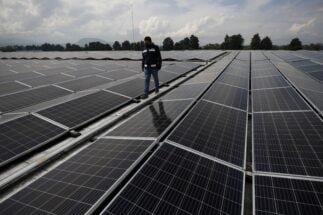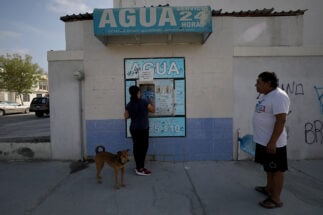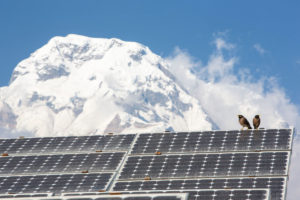After three years steadfastly backing the oil industry, the Mexican government has announced a new renewable energy plan that could serve as a springboard for the country’s energy transition.
Presented at the recent COP27 climate summit in Egypt, the Sonora Plan features a range of green infrastructure initiatives in the northern state of the same name, aimed at boosting the country’s renewable power and manufacturing capacity. These include the construction of one of the world’s largest solar power plants in the city of Puerto Peñasco, the exploitation of the state’s lithium reserves, the production of parts for electric vehicles, and the expansion of the state’s principal port of Guaymas – vital for exporting minerals and cars.

The plan comes after several years of diplomatic wrangling and pressure from the neighbouring United States. Since January 2020, the US special envoy for climate, John Kerry, has visited Mexico on at least three occasions, in an effort to convince Mexican president Andrés Manuel López Obrador, popularly known as AMLO, to promote renewable energy. The US has accused Mexico of violating the terms of the United States-Mexico-Canada trade agreement, given the AMLO government’s policies that restrict private companies from participating in Mexico’s electricity sector, seen by the US as a barrier to investment in renewables.
For Jeremy Martin, vice president for energy and sustainability at the Institute of the Americas, a US NGO, the Sonora Plan is a “political result of a dedicated effort” by the United States, but still lacks definition.
“Right now, we don’t know much [about the plan]. It’s just a profile, but the fine print is missing. There are objectives, some ideas, but there is still a lot to define,” Martin said.
Solar in the Sonora Plan
The Puerto Peñasco solar plant, one of the Sonora Plan’s headline items, is not a new project, with the state-owned Federal Electricity Commission (CFE) having already begun construction of the facility in May. Expected to cost US$1.6 billion, the plant will have an installed capacity of 1,000 megawatts, placing it as the largest facility of its kind in Latin America, and among the largest in the world. It will supply the state of Sonora with 120 MW, while 880 MW will be dedicated to the neighbouring state of Baja California via a 144-kilometre long transmission line, serving approximately 1.6 million people across both areas.

The first phase, scheduled to enter into operation next April, will generate 120 MW and the second, by 2024, 300 MW, with the remaining capacity scheduled to be completed by 2027.
The plant is located in the coastal municipality of Puerto Peñasco, some 2,300 kilometres from Mexico City, in an area that already has abundant energy generation. The state of Sonora is already home to eight solar power plants, with two more under construction, as well as a wind farm, seven gas-powered combined cycle plants and an oil-fired thermoelectric plant.
For Nélida Barajas, general director of the Sonora-based Intercultural Center for the Study of Deserts and Oceans (CEDO), the Puerto Peñasco solar park is a step in the right direction, but it is not enough.
The plant, Barajas said, “can boost local economies by diversifying activities. It can generate cheaper electricity and lead to internet access and [help to supply] drinking water.” But with the facility’s launch coming as a relatively sudden development, she said that realising these benefits will require strong forward planning, the extent of which is currently unknown, with no written version of the plan yet available in the public domain.
Lithium, the key player
A more complex aspect of the Sonora Plan lies in its proposals for the extraction of lithium, a fundamental mineral for the manufacture of batteries for electric vehicles (EVs).
In August, the Mexican government decreed the creation of a state-owned lithium company, Lithium for Mexico (LitioMx), which will be responsible for the exploration, exploitation and use of the resource, as well as the development of strategies and projects relating to it. But the company is yet to receive an assigned budget from the state.
The government envisions using its national lithium reserves to assemble batteries for EVs. But one barrier lies in the fact that deposits of the mineral in Sonora are found in clay rather than brine, a characteristic that requires specialised and potentially costly technology to extract. In conventional extraction – for example, in Chile, home to the world’s largest lithium reserves – the mineral is exploited by sun-drying brines to obtain lithium carbonate. In either case, obtaining it requires large volumes of water.

This is likely to present an obstacle in Mexico’s frequently drought-stricken north. Of the 60 existing aquifers in Sonora, 19 are at a deficit as extraction exceeds recharge, representing a total annual shortfall of 526 million cubic metres in 2020, according to numbers from the government’s National Water Commission.
There were 16 confirmed lithium mining projects in Mexico in 2021, of which five are located in Sonora, according to the Ministry of Economy’s General Directorate of Mining Development. While most are in the exploratory phases, the most advanced belongs to Bacanora Lithium, a subsidiary of Chinese mining firm Ganfeng Lithium, which has previously said it plans to begin construction of a refining plant in 2023. Bacanora reports that the Sonora site could contain as much as 8.8 million tonnes of lithium, which would make it one of the largest deposits in the world.
The potential of electric vehicles
During the COP26 climate summit, held in Glasgow, Scotland in November 2021, Mexico was a signatory to the Accelerating to Zero coalition, an agreement which seeks to promote zero-emissions vehicle uptake and eliminate the production of internal combustion vehicles by 2040. Mexico has ambitions of promoting domestic manufacturing of EVs and to use locally extracted lithium in the production of batteries. But there are, as yet, no details on such operations, and it is unclear how supply and production chains between lithium extraction and battery production would integrate, among other questions.

Given the country’s well established automaking industry, there is evident potential for EV production in Mexico. Around 5% of the vehicles manufactured in the country this year have been electric, with four assembly lines currently active, producing vehicles primarily for the US market: Ford, which builds its Mustang Mach-E at a Mexican factory; Giant Motors, its JAC line; Audi, the Q5 model; and Zacua, Mexico’s first homegrown electric car brand. Several other manufacturers have announced plans to produce EVs in Mexico, including General Motors, Volkswagen and Bolivia’s Quantum.
The 2040 goal and rising exports, mainly to the United States, should encourage Mexico to promote its electric vehicle industry, with the Sonora Plan likely to provide stimulus for this. The Mexican government has earmarked US$48 billion of investment across the sectors associated with the plan, and included a goal for 50% of its vehicle production to be zero-emissions by 2030.

Lithium is a fundamental component in the production of EV batteries, but the assembly of batteries is practically non-existent in Mexico at present. Companies from Germany, China, South Korea and Singapore dominate the global market, which Mexico is intending to enter with little technical knowledge and experience.
For Martin, the unknown lies in how extracted lithium could be converted into finished products in Mexico, such as batteries or semiconductors, as envisioned by the government. Lopez Obrador has said that private companies could partner with CFE or LitioMx to generate these processes.
“The government says there may be private partners, but there is a lack of clarity in this regard,” Martin said. “The first thing you must see to is that companies are established. The problem is how long it will take to build that chain, and companies do not pop up like mushrooms, overnight. I don’t know how we can jump that gap in the medium term.”
Before the arrival of the Sonora Plan, Mexico’s energy transition had appeared to be on hold. Since AMLO took power in 2018, his government has enacted and upheld energy policies favouring fossil fuel policies, supporting oil, gas and hydroelectric plants to the detriment of wind and solar energy. As the president heads into the final two years of his term, whether or not the new plan can change this situation remains to be seen.








